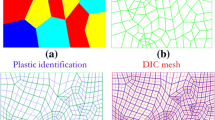Abstract
Today, the identification of material model parameters is based more and more on full-field measurements. This article explains how an appropriate use of the constitutive equation gap method (CEGM) can help in this context. The CEGM is a well-known concept which, until now, has been used mainly for the verification of finite element simulations. This has led to many developments, especially concerning the techniques for constructing statically admissible stress fields. The originality of the present study resides in the application of these recent developments to the identification problem. The proposed CEGM is described in detail, then evaluated through the identification of heterogeneous isotropic elastic properties. The results obtained are systematically compared with those of the equilibrium gap method, which is a well-known technique for the resolution of such identification problems. We prove that the use of the enhanced CEGM significantly improves the quality of the results.
Similar content being viewed by others
References
Sutton MA, Wolters WJ, Peters WH, Ranson WF, McNeill SR (1983) Determination of displacements using an improved digital correlation method. Image Vis Comput 1(3): 133–139
Sutton MA, Mingqi C, Peters WH, Chao YJ, McNeill SR (1986) Application of an optimized digital correlation method to planar deformation analysis. Image Vis Comput 4(3): 143–150
Kim J-H, Pierron F, Wisnom MR, Syed-Muhamad K (2007) Identification of the local stiffness reduction of a damaged composite plate using the virtual fields method. Compos A 38: 2065–2075
Périé JN, Leclerc H, Roux S, Hild F (2009) Identification of anisotropic damage laws using digital image correlation. In: Proceeding of JNC16
Lubineau G (2008) Estimation of residual stresses in laminated composites using field measurements on a cracked sample. Compos Sci Technol 68(13): 2761–2769
Pierron F, Green B, Wisnom MR, Hallett SR (2007) Full-field assessment of the damage process of laminated composite open-hole tensile specimens. Compos A 38: 2321–2332
Becker R, Vexler B (2004) A posteriori error estimation for finite element discretization of parameter identification problems. Numer Math 96: 435–459
Latourte F, Chrysochoos A, Pagano S, Wattrisse B (2008) Elastoplastic behaviour identification for heterogeneous loadings and materials. Exp Mech 48: 435–449
Mahnken R (2004) Identification of material parameters for constitutive equations. In: Encyclopedia of computational mechanics, vol 2. Part 2: solids and structures, chap 19. Wiley, New York
Grediac M, Pierron F (2006) Applying the virtual fields method to the identification of elasto-plastic constitutive parameters. Int J Plasticity 22: 602–627
Lubineau G (2009) A goal-oriented field measurement filtering technique for the identification of material model parameters. Comput Mech 44(5): 591–603
Grédiac M (1989) Principe des travaux virtuels et identification. Comptes-Rendus Mecanique 309: 1–5
Grédiac M, Toussaint E, Pierron F (2002) Identification of the mechanical properties of materials with the virtual fields method, an alternative to finite element model updating. Comptes-Rendus Mecanique 330(2): 107–112
Avril S, Huntley JM, Pierron F, Steele DD (2008) 3d Heterogeneous stiffness reconstruction using MRI and the virtual fields method. Exp Mech 48: 479–494
Kavanagh KT, Clough RW (1971) Finite element application in the characterization of elastic solids. Int J Solids Struct 7: 11–23
Lecompte D, Sol H, Vantomme J, Habraken AM (2005) Identification of elastic orthotropic material parameters based on espi measurements. In SEM annual conference and exposition on experimental and applied mechanics, June 2005
Ikehata M (1990) Inversion formulas for the linearized problem for an inverse boundary value problem in elastic prospection. SIAM J Appl Math 50: 1635–1644
Claire D, Hild F, Roux S (2007) Identification of a damage law by using full-field displacement measurements. Int J Damage Mech 16: 179–197
Claire D, Hild F, Roux S (2002) Identification of damage fields using kinematic measurements. Comptes-Rendus Mecanique 330: 729–734
Geymonat G, Hild F, Pagano S (2002) Identification of elastic parameters by displacement field measurement. Comptes-Rendus Mecanique 330(6): 403–408
Calloch S, Dureissex D, Hild F (2002) Identification de modèles de comportement de matériaux solides: utilisation d’essais et de calculs. Technol Form 100: 36–41
Avril S, Bonnet M, Bretelle A-S, Grédiac M, Hild F, Ienny P, Latourte F, Lemosse D, Pagano S, Pagnacco E, Pierron F (2008) Overview of identification methods of mechanical parameters based on full-field measurements. Exp Mech 48: 381–402
Avril S, Pierron F (2007) General framework for the identification of constitutive parameters from full-field measurements in linear elasticity. Int J Solids Struct 44: 4978–5002
Florentin E, Gallimard L, Pelle J-P (2002) Evaluation of the local quality of stresses in 3d finite element analysis. Comput Methods Appl Mech Eng 191(39–40): 4441–4457
Lubineau G, Ladeveze P, Violeau D (2006) Durability of CFRP laminates under thermomechanical loading: a micro-meso damage model. Compos Sci Technol 66(7–8): 983–992
Lubineau G, Ladevèze P (2008) Construction of a micromechanics-based intralaminar mesomodel, and illustrations in abaqus/standard. Comput Mater Sci 43(1): 137–145
Florentin E, Gallimard L, Ladevèze P, Pelle J-P (2003) Local error estimator for stresses in 3d structural analysis. Comput Struct 81(18–19): 1751–1757
Florentin E, Gallimard L, Pelle J-P, Rougeot P (2005) Adaptive meshing for local quality of finite element stresses. Eng Comput 22-2: 149–164
Ladevèze P, Florentin E (2006) Verification of stochastic models in uncertain environments using the constitutive relation error method. Comput Methods Appl Mech Eng 196(1–3): 225–234
Adeveze P, Chamoin L, Florentin E (2010) A new non-intrusive technique for the construction of admissible stress fields in model verification. Comput Methods Appl Mech Eng 199(9–12): 766–777
Roux S, Hild F (2008) Digital image mechanical identification. Exp Mech 48(4): 495–508
Périé J-N, Calloch S, Cluzel C, Hild F (2002) Analysis of a multiaxial test on a c/c composite by using digital image correlation and a damage model. Exp Mech 42(3): 318–328
Périé J-N, Leclerc H, Roux S, Hild F (2009) Digital image correlation and biaxial test on composite material for anisotropic damage law identification. Int J Solids Struct 46: 2388–2396
Author information
Authors and Affiliations
Corresponding author
Rights and permissions
About this article
Cite this article
Florentin, E., Lubineau, G. Identification of the parameters of an elastic material model using the constitutive equation gap method. Comput Mech 46, 521–531 (2010). https://doi.org/10.1007/s00466-010-0496-y
Received:
Accepted:
Published:
Issue Date:
DOI: https://doi.org/10.1007/s00466-010-0496-y




